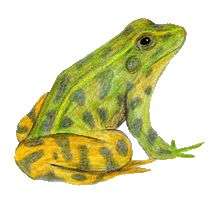Created by Peter Maas for The Extinction Website. This image has been released under the Creative Commons Attribution Non-commercial No Derivatives 3.0 Licence.
The Vegas Valley Leopard Frog is the only North American frog officially considered to have gone extinct in recent history (c. 1942). But through the efforts of a multi-agency genetic investigation comprised of dedicated researchers from the Las Vegas Springs Preserve, Fordham University, University of Nevada Las Vegas, University of Arizona, Arizona Game and Fish Department, the U.S. Environmental Protection Agency, and Tulane University it has been discovered that the frog is not extinct, but genetically identical to a species located 250 miles away from Las Vegas.
“There are several species of leopard frogs in the southwest and, even though they are not the same species, they all look quite similar even to herpetologists—biologists who study amphibians and reptiles,” said Dr. Raymond Saumure, Springs Preserve Biologist, who initiated the study. Dr. Saumure became interested in the frog because the Las Vegas Springs Preserve was one of three spring systems once inhabited by the species.
“What we initially set out to do,” said Dr. Saumure “was to determine if the Vegas Valley Leopard Frog (Rana fisheri) was the same species as the imperiled Relict Leopard Frog (Rana onca) found along tributaries of the Colorado River, several miles to the east.”
To answer that question, Dr. Evon Hekkala, then a post-doc at Tulane University, was enlisted to conduct the genetic analyses. To make the study possible, useable DNA had to be extracted from Vegas Valley Leopard Frogs collected in Las Vegas in 1913 and housed at the California Academy of Sciences.
“Our first success was to extract useable strands of DNA from these frogs preserved almost 100 years ago” says Dr. Hekkala, now an Assistant Professor at Fordham University.
The initial results were discouraging, despite their physical similarities and geographic proximity, the frogs were not the same species. The question remained whether the Vegas Valley Leopard Frog was truly extinct.
With the DNA extracted, Dr. Hekkala was able to compare it to data in GenBank, a database that contains DNA sequence data for a myriad of organisms, including 62 other species of frogs from North America.
What the research team found, as published in the scientific journal “Conservation Genetics”, was that the Vegas Valley Leopard Frog was virtually identical, genetically speaking, to the Threatened Chiricahua Leopard Frog (Rana chiricahuensis), a species whose DNA was being studied independently by the Arizona co-authors.
“It meant” says Dr. Hekkala “that the only North American frog species currently listed as extinct was not extinct!”
For a team of conservation-minded biologists, it meant that they’d been given a second chance. Today, the closest Chiricahua Leopard Frog population, direct relatives of the Vegas Valley Leopard Frog is in the Mogollon Rim in central Arizona, some 250 miles to the southeast of Las Vegas.
More information: Click here to access published article.
Source: Springs Preserve




















